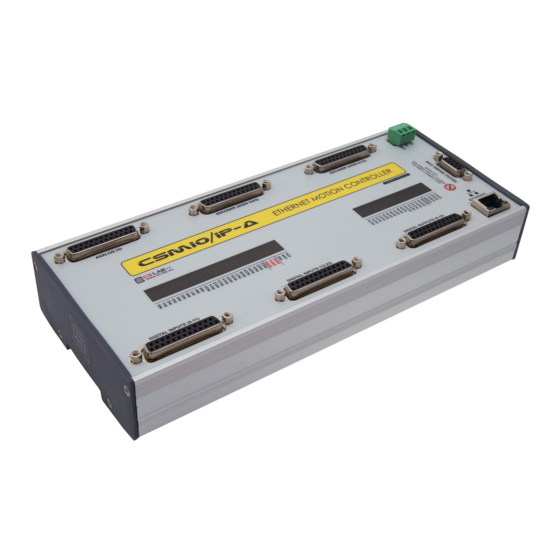Summary of Contents for CS-Lab CSMIO/IP-A
- Page 1 CSMIO/IP-A 6-axis CNC motion controller (+/-10V) Manual Tuning Guide with Mach4 software APPLIES TO: HARDWARE VER. FIRMWARE (software) v2 FP4 v3.xxx (Mach4) v2 H7 © copyright CS-Lab s.c. 2020: Rev 1.1 (08/2021)
-
Page 2: Before You Start
In the case of newer servo drives, this will be possible using a dedicated diagnostic utility for the servo drive. In the case of older servo drives, using an oscilloscope and test points indicated on the servo PCB by a manufacturer in a product manual. CS-Lab s.c. | CSMIO/IP-A 6-axis CNC controller. Manual tunning... - Page 3 Connect the analog signal +/-10V If you skip any of the above steps, tunning CSMIO/IP-A position PID regulator may fail or be dangerous. To make the tuning safe and undisturbed, only one servo drive should be enabled at a time, for which the PID loop of the CSMIO/IP-A controller position has not been tuned yet.
- Page 4 PID regulator of the CSMIO/IP-A controller po- sition is not tuned yet.
- Page 5 CSMIO / IP-A controller and the servo drive is connected correctly. You should also check the settings of the counterpart of the "Zero Offset" parameter in the servo settings. CS-Lab s.c. | CSMIO/IP-A 6-axis CNC controller. Manual tunning...
- Page 6 "Enable" state and run gcode. If you have done everything correctly so far, the axis should move forward and backward, giving us the ability to tune it in real-time. You should see a view similar to the one below on the oscilloscope screen CS-Lab s.c. | CSMIO/IP-A 6-axis CNC controller. Manual tunning...
- Page 7 In this case, the velocity given by the gcode is 1000mm/min, which is ap- proximately 16,66mm/s. You can read this value from the chart the same way we did above. CS-Lab s.c. | CSMIO/IP-A 6-axis CNC controller. Manual tunning...
- Page 8 "Trigger" function. If you do not know why the "Mkit Ref Velocity" value has the trapezoidal shape, let us remind you that Mach4 uses a trapezoidal motion velocity profile. CS-Lab s.c. | CSMIO/IP-A 6-axis CNC controller. Manual tunning...
- Page 9 "Mkit Ref Velocity" value (set velocity that an axis should get when making a set move) will go directly to the +/-10V analog output of a CSMIO/IP-A controller. "Feed forward" of velocity greatly supports the proportional term of the position PID regulator, and thus the value of the "kP"...
- Page 10 Below you can see slides that show searching for a proper value of "KVff". Start Step 1 Step 2 Step 3 Step 4 Step 5 Step 6 Step 7 Step 8 Step 9 Step 10 Step 11 Step 12 Step 13 Step 14 CS-Lab s.c. | CSMIO/IP-A 6-axis CNC controller. Manual tunning...
- Page 11 Please notice that the "Mkit Following Error" value in the discussed case is currently only 0,04mm (Val / Div = 0,01mm x 4 oscilloscope grids). This proves that the "Feed forward" of velocity strongly supports the work of the proportional term of the PID regulator. CS-Lab s.c. | CSMIO/IP-A 6-axis CNC controller. Manual tunning...
- Page 12 The "kP" parameter is a value of proportional term gain of the position PID regulator. In simplification, the higher "kP" and "Mkit Following Error" value, the higher voltage value will go to the +/-10V analog output of CSMIO/IP-A controller. CS-Lab s.c. | CSMIO/IP-A 6-axis CNC controller. Manual tunning...
- Page 13 Further increasing of the "kP" by 0.02, causes the "Mkit Following Error" value does not decrease and axis' resonance intensifies. We reduce the "kP" to Step 21 value, and we consider it the target value and go to the next stage. CS-Lab s.c. | CSMIO/IP-A 6-axis CNC controller. Manual tunning...
- Page 14 The "kAff" parameter is a gain value of acceleration, "feed forward". In simplification, the higher "kAff" value, the higher value of voltage proportional to the value of "Mkit Ref Acceleration" (the set accelera- tion, which an axis should get when making a set move) will go to +/-10V analog output of CSMIO/IP-A controller.
- Page 15 We increase the "kAff" by 0.1, the value of "Mkit Following Error" changes the sign. We reduce the "kAff" value to Step 30 value, and we consider it the target value and go to the next stage. CS-Lab s.c. | CSMIO/IP-A 6-axis CNC controller. Manual tunning...
- Page 16 The "kI" is a value of integral term gain of position PID regulator. In simplification, the higher "kI" and "Mkit Following Error" value and the longer the value lasts, the higher voltage value will go to the +/-10V analog output of a CSMIO/IP-A controller. CS-Lab s.c. | CSMIO/IP-A 6-axis CNC controller. Manual tunning...
- Page 17 PID regulator doesn't have an integral term or does not fulfill its task sufficiently due to the servo drive's outdated design." Start Step 36 Step 37 Step 38 Step 39 Step 40 Step 41 Step 42 Step 43 Step 44 Step 45 Step 46 Step 47 CS-Lab s.c. | CSMIO/IP-A 6-axis CNC controller. Manual tunning...
- Page 18 The "kD" parameter should be used only when it is necessary. For servo drives that work correctly, this parameter does not need to be used. Unjustified use of this parameter may reduce the servo drive's response time and increase the value of "Mkit Following Error". CS-Lab s.c. | CSMIO/IP-A 6-axis CNC controller. Manual tunning...
- Page 19 CS-Lab s.c. | CSMIO/IP-A 6-axis CNC controller. Manual tunning...
-
Page 20: Final Steps
4) After a month or two, you should check if a repeated tuning of the PID regulator of your CSMIO/IP-A controller position is not required. This is usually necessary only for CNC machines that have not been used for a long time because of flushing out thickened or dried grease or oil by their central lubrication system.




Need help?
Do you have a question about the CSMIO/IP-A and is the answer not in the manual?
Questions and answers